kal
Well-Known Member
I'm building a 100% electric setup with 3 Blichmann 20 gallon pots.
I will be using 5500W/240V ULWD electric heating elements in the HLT and the BK.
I'm planning on using a PID + 40A SSR/heatsink + RTD temp sensor to control both the BK and and HLT separately. Duplicate equipment for both to make it simpler (no cable switching needed). That part I understand. The boil kettle PID will be running in manual mode and in 'regular' mode(for lack of a better term) in the HLT.
Everything's going to be ordered from Auberins.com.
PID with SSR output:

Link: http://auberins.com/index.php?main_page=product_info&cPath=1&products_id=3
Liquid tight RTD temp sensor, 4" probe, 1/4" NPT thread:

Link: http://auberins.com/index.php?main_page=product_info&cPath=15&products_id=85
40A SSR & Heatsink
SSR: http://auberins.com/index.php?main_page=product_info&cPath=2&products_id=30
Heatsink: http://auberins.com/index.php?main_page=product_info&cPath=2&products_id=77
There will be a HERMS coil in the HLT to recirc from the MLT to maintain mash temp and to allow for future step-mashes. I'm using an uninsulated Blichman 20 gallon pot for the mash so temp won't be maintained very well without HERMS and I don't want to cover up the nice pot with insulation.
I was going to put another RTD temp sensor in the MLT to cycle a pump on/off with a PID. This pump would recirc the sweet wort through 25' of copper coil in the HLT during mash. This would require a third PID. I was told however that I can't do this as a PID would try and cycle the pump on/off too much which isn't good for the pump. Makes sense, but this seems to be the way that the B3 BrewSculptures work. From the BrewSculptures user manual:
"If using the SMART or Digital SMART system, you will set the controller to 152°F and allow the recirculation to maintain the mash temperature for the entire duration of the mash. The pump will switch on and off automatically to recirculate the mash liquid through the coil in the hot liquor tank and back to the top of the mash tun. This will clarify the wort and will allow you to keep the temperature steady during the entire mash."
Sounds exactly like what I want to do. No? Or do I use some sort of LOVE-style controller with lag instead of a PID so that the pump doesn't get turned on/off fast? A LOVE controler just looks at the temp and either turns the output on or off instead of learning and cycling power (similar to duty cycle).
A LOVE controller:

Questions:
How do most single tier electric guys do HERMS? Do they have 3 PIDs (or 2 PID and a discrete on/off LOVE-style controller for HERMS)?
What am I missing here?
I've also never seen anyone with THREE controllers on their control panel. I understand that you can use one PID for the HLT and BK but then I assume you need a low voltage switch for the low voltage side of the SSR to choose which element the PID is controlling (I'm assuming that in manual mode a PID ignores the temp sensor).
I'm ready to place a large order at Auberins.com for the core electrical stuff but want to make sure my process is clear first.
Kal
I will be using 5500W/240V ULWD electric heating elements in the HLT and the BK.
I'm planning on using a PID + 40A SSR/heatsink + RTD temp sensor to control both the BK and and HLT separately. Duplicate equipment for both to make it simpler (no cable switching needed). That part I understand. The boil kettle PID will be running in manual mode and in 'regular' mode(for lack of a better term) in the HLT.
Everything's going to be ordered from Auberins.com.
PID with SSR output:

Link: http://auberins.com/index.php?main_page=product_info&cPath=1&products_id=3
Liquid tight RTD temp sensor, 4" probe, 1/4" NPT thread:

Link: http://auberins.com/index.php?main_page=product_info&cPath=15&products_id=85
40A SSR & Heatsink
SSR: http://auberins.com/index.php?main_page=product_info&cPath=2&products_id=30
Heatsink: http://auberins.com/index.php?main_page=product_info&cPath=2&products_id=77
There will be a HERMS coil in the HLT to recirc from the MLT to maintain mash temp and to allow for future step-mashes. I'm using an uninsulated Blichman 20 gallon pot for the mash so temp won't be maintained very well without HERMS and I don't want to cover up the nice pot with insulation.
I was going to put another RTD temp sensor in the MLT to cycle a pump on/off with a PID. This pump would recirc the sweet wort through 25' of copper coil in the HLT during mash. This would require a third PID. I was told however that I can't do this as a PID would try and cycle the pump on/off too much which isn't good for the pump. Makes sense, but this seems to be the way that the B3 BrewSculptures work. From the BrewSculptures user manual:
"If using the SMART or Digital SMART system, you will set the controller to 152°F and allow the recirculation to maintain the mash temperature for the entire duration of the mash. The pump will switch on and off automatically to recirculate the mash liquid through the coil in the hot liquor tank and back to the top of the mash tun. This will clarify the wort and will allow you to keep the temperature steady during the entire mash."
Sounds exactly like what I want to do. No? Or do I use some sort of LOVE-style controller with lag instead of a PID so that the pump doesn't get turned on/off fast? A LOVE controler just looks at the temp and either turns the output on or off instead of learning and cycling power (similar to duty cycle).
A LOVE controller:

Questions:
How do most single tier electric guys do HERMS? Do they have 3 PIDs (or 2 PID and a discrete on/off LOVE-style controller for HERMS)?
What am I missing here?
I've also never seen anyone with THREE controllers on their control panel. I understand that you can use one PID for the HLT and BK but then I assume you need a low voltage switch for the low voltage side of the SSR to choose which element the PID is controlling (I'm assuming that in manual mode a PID ignores the temp sensor).
I'm ready to place a large order at Auberins.com for the core electrical stuff but want to make sure my process is clear first.
Kal




